
The sound was unmistakable, and the kids came a’runnin’.
The time was shortly after World War I. The place, almost anywhere that there was an area long enough and flat enough. The sound was the coughing and sputtering of those early engines at the front of any of a variety of war-surplus airplanes. The few surviving military aviators and others who sought adventure had been able to purchase the planes, Curtiss Jenny trainers and the like, and they had set off to find their fortunes.
This often meant flying from small town to small town, picking out places that would work as a “landing strip” — later “airfield,” because this was before emasculated gray men in gray offices invented words like “infrastructure” to suck the life out of the world around us — and bringing excitement and fun. Many people hadn’t seen an airplane before and almost no one had flown in one. For a few dollars — a lot at the time — you could take a hop around the field. On the way out of town, the pilot might make a few low passes, maybe even execute a roll or two.
As time went on, the process became a little more formal. First came the “barnstormers,” individual pilots who flew all sorts of stunts, and “flying circuses,” groups of pilots who traveled together, performing their stunt routines, engaging in mock dogfights, and offering rides to paying customers. They would come and go as they became mail pilots, got killed, or both. Their performances remained popular until World War II, when pilots and aviation fuel had other things to do.
As with barnstorming, modern airshows were fertilized by the availability of cheap high-performance military surplus aircraft following a world war, as well as the now-unemployed, highly skilled pilots who had flown them, and a public eager to witness the derring-do that had brought us to victory. Everybody liked airplanes, and we were told that before long we’d all soon be flying planes of our own.
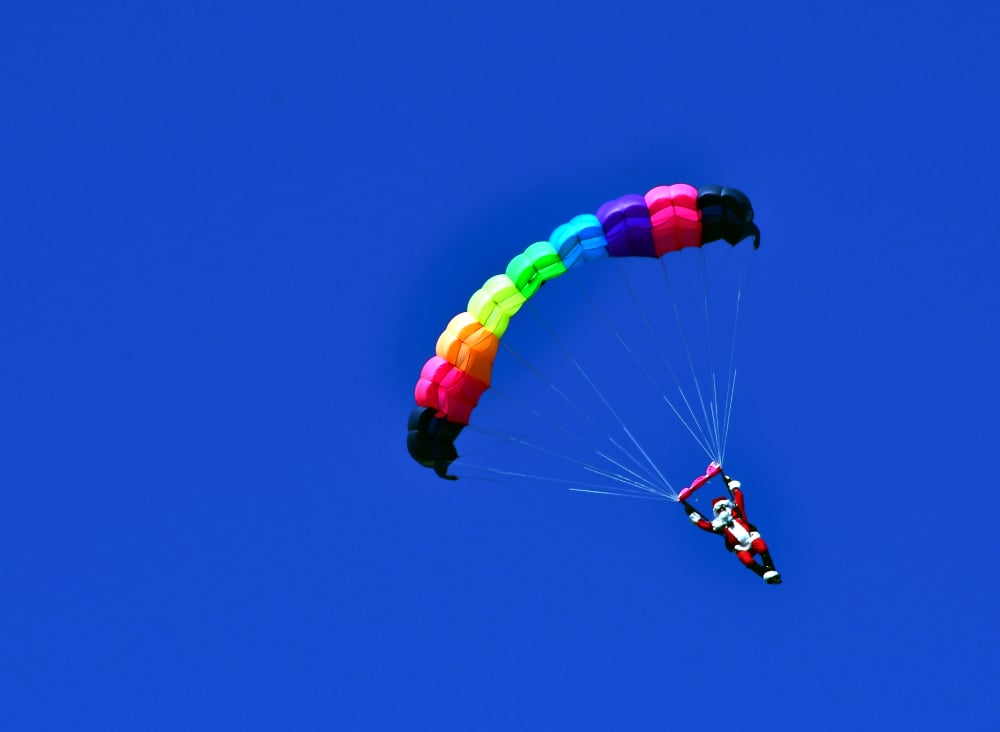
There came to be something very like the original barnstorming, in which notable individual airplanes tour the country, stopping at airports of all sizes. A few years ago it was my honor to take a hop on the restored B-17 “Aluminum Overcast,” flying that day out of the little airport in Zanesville, Ohio.
The barnstorming spirit lives on in the modern-day airshow, though that term is a little like “waterway,” covering a whole panoply of things that share a single characteristic. It has been my undeserved good fortune to attend many of them, large and small, national and local. (I’ve made pictures at some of them, but rather than festoon this little column with way too many pictures, I’m including as we go along links to picture albums I’ve made of some of them.) The gold standard is the Experimental Aircraft Association’s “AirVenture” fly-in each July in Oshkosh, Wisconsin. There are others; the ones I’ve attended include Sun’n’Fun in Lakeland, Florida and the MKE Air & Water Show in Milwaukee.
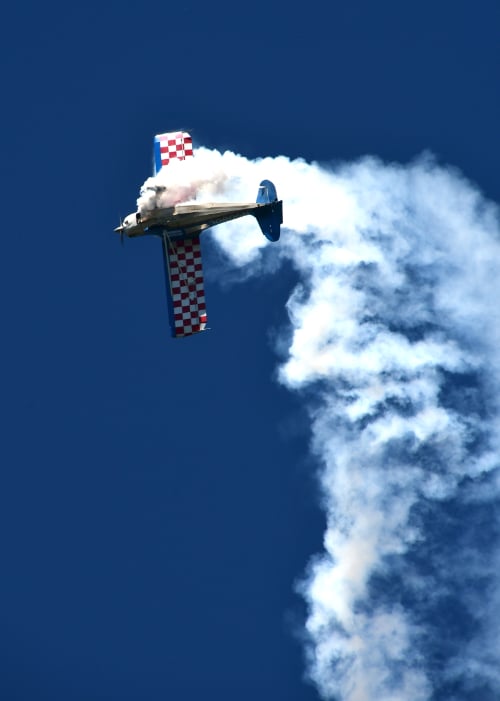
I’ve flown with aerobatic masters, among them the legendary Debbie Gary, who was in Fort Lauderdale for a performance in that city’s airshow. And via friends made through my sister and her aircraft interior shop at Fort Lauderdale’s Executive Airport, I was able to go for an aerobatic hop pretty much whenever I wanted. (It was fun to fly aerobatics in planes like the Siai-Marchetti SF260, but pure joy required Fern Forrest and his Albee Sport open-cockpit biplane.) But I digress, as sometimes happens
Today there are hundreds of airshows all across the country. My favorites, Oshkosh notwithstanding, are the local ones held at small airports. It was therefore with welcome delight that I got to go to the Vinton County Air Show in New Plymouth, Ohio last Sunday afternoon. There are fewer than 13,000 people living in Vinton County, but well over 1000 people attended, and the airport isn’t all that conveniently located. It was worth the drive and then some.
This was the 50^th^ show there; it was to have been last year, but 2020, so it was postponed. It comprised the things that make local airshows so special. In front of the main airport building was one of the biggest barbecue pits I’d ever seen, atop which were the product of a good-sized chicken farm. “A third of the people come for the chicken and don’t know there’s an airshow,” said Bob Church, a skydiver who performed there, and a friend I’ve known for years and years but was meeting in person for the first time — you know, the internet. “And a third come for the air show and don’t know about the chicken.” It’s a giant country picnic with airplanes!
After a meeting of the many emergency and fire people there was the pilots meeting. It’s here that participants learn the radio frequencies in use during the show, the holding area in case something happens to prevent use of the runway while pilots are aloft, the nearby diversion airports, the signal in case there’s a stuck mic on somebody’s radio (which blankets the frequency, making it unusable), and so on.
Then Bob and fellow jumpers Scott Adams and Ted Williams climbed into a Cessna 172 flown by Harry Sowers and, after they got to 4000 feet, the show began. The jumpers were followed by aerobatic flying of several sorts, including the moldy old trick that always works, no matter how often you’ve seen it: The pilot cuts the engine while very low and disappears behind the trees, out of sight, heading toward the ground. After he’s been gone just long enough that even the old veteran airshow watchers are concerned, up he pops, flying along happy as you please.
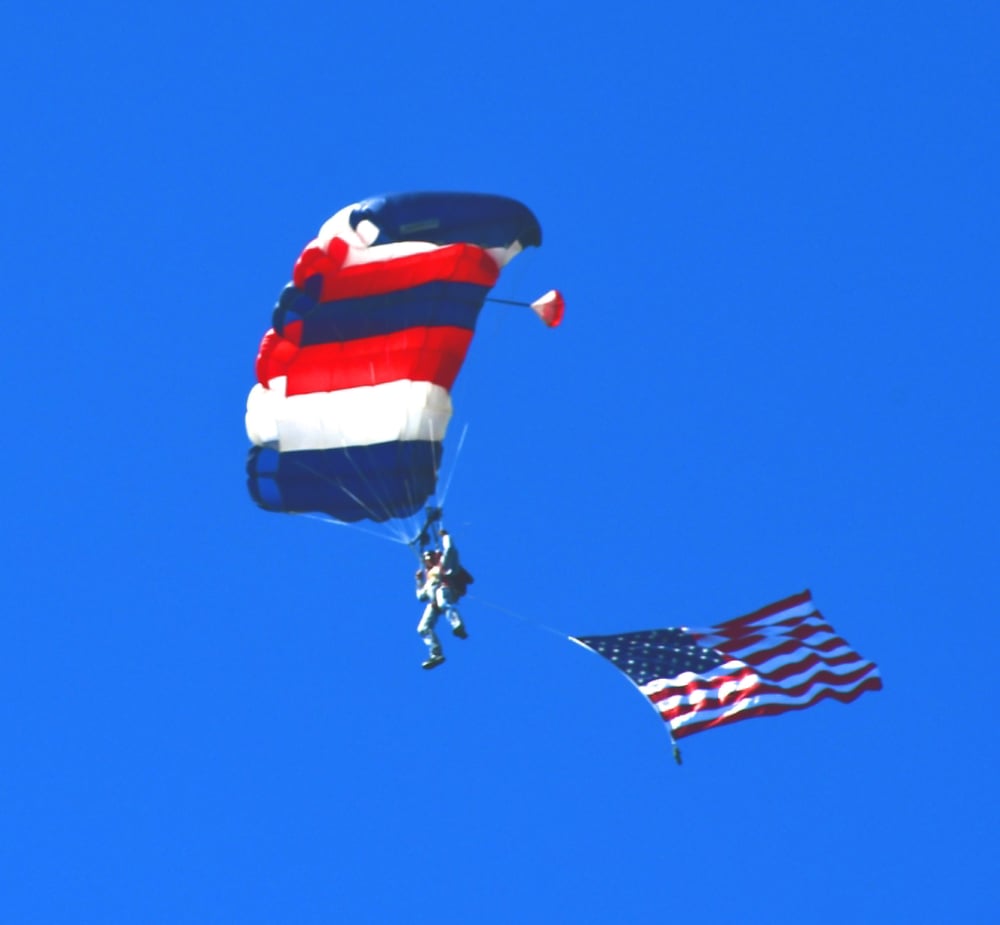
The local radio-controlled airplane club was there and demonstrated some of the members’ impressive projects, including a stunning (and really expensive) model jet. Flying aerobatics in an RC plane isn’t an easy thing. It’s even more difficult when what you’re flying is a lawnmower. The club demonstrated “foamies,” the radio-controlled planes made of styrofoam that are both inexpensive and forgiving of crashes. They’re a sensible gateway to a hobby that has recently been overtaken by people with drones.
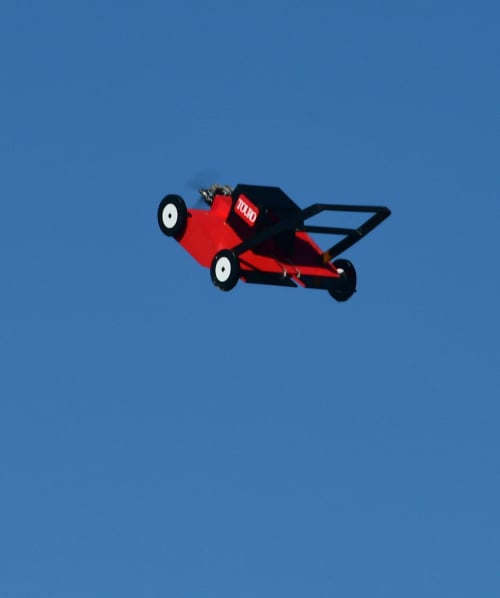
There was a demonstration by the local rocketry club as well. I suppose that if I had a criticism it would be that models, both airplanes and rockets, are interesting to watch, but in the midst of big airplanes whose pilots are putting their own backsides on the line those hobbies can get lost. I offer no solution except to encourage spectators — myself among them — to pay attention to the little aircraft, too.
Of course, everything got lost when Tico took to the air. Robert “Tico” LaCerda is a commercial 747 captain in real life, but on weekends he pulls shut the bubble canopy of his overpowered Pitts Special biplane and goes all Philadelphia lawyer on the laws of physics. He takes off and within a hundred feet of rotation he’s flying sideways, smoke on, just off the runway, nose way high. In the next fifteen minutes he does dozens of things that your flight instructor told you never ever to do because they will certainly kill you. His plane is Baron von Richthofen red, his engine very loud — when he cuts the engine as he is wont to do, it gets your attention just as much as its volume did when he flew past the first time. But it’s all part of a very good act.

This isn’t to minimize the skills of the other talented pilots in the sky over the Vinton County Airport that day, not in the slightest. From beginning to end, the show demonstrated really good flying. Tico was loudest and flashiest, though.
There was one highly peculiar event. In the middle of the show an Ercoupe, a cool little airplane that was the one that was supposed to make us all pilots, landed on the Vinton County Airport runway. It wasn’t part of the air show. The runway was marked at each end with large “X”s, signifying that it was closed. There are other nearby airports. Yet right in the middle of an air show the plane Mr. Magoo would fly just puttered on in. (Or the plane Joe Biden would crash, then condemn the airport for not being where he landed.) I have no idea how it turned out, but there were FAA inspectors on the field and I don’t believe anyone there would have liked being that pilot, even if it meant getting to have a nifty airplane.
In due course Bob Church disappeared and, a little while later, Santa Claus appeared in his place. Santa climbed into the Cessna and took off, and in a little while the jolly old elf appeared, hanging from Bob Church’s canopy. He strode forward to talk to the several hundred kids; while he did this Harry Sowers flew the plane low down the runway while Scott Adams dumped candy from a 5-gallon bucket. The 172 landed and after all props on the airfield were dead stopped, the children were set free. They ran out and collected the candy (and probably, too, any woebegone grasshopper that had landed there) and retreated. From that point, a flying saucer could have landed and the kids would have missed it. This is the kind of thing you don’t see at the bigger airshows.
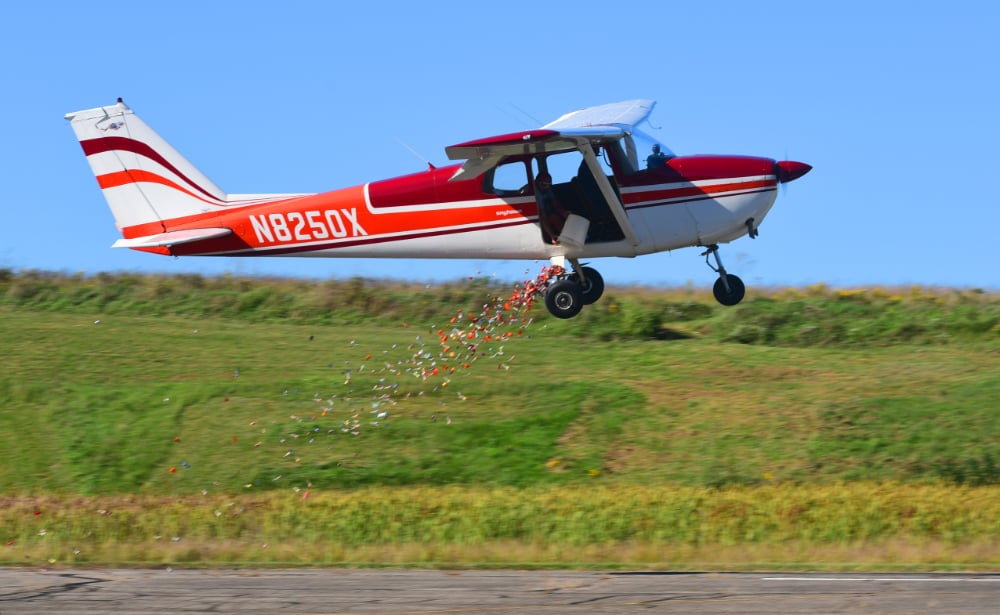
Then came what I’m glad they saved for last.
I noticed that something was up when Tico’s biplane and the RV-6 kit plane of Brett Hunter pulled off the ramp and onto the active, taxiing in opposite directions. I was pretty sure what they were going to do, and I wanted to photograph it. There would be about 1/100th of a chance.
I got lucky. They happened to be where I wanted them when the camera went off. The result is shown here. The caption tells the story.
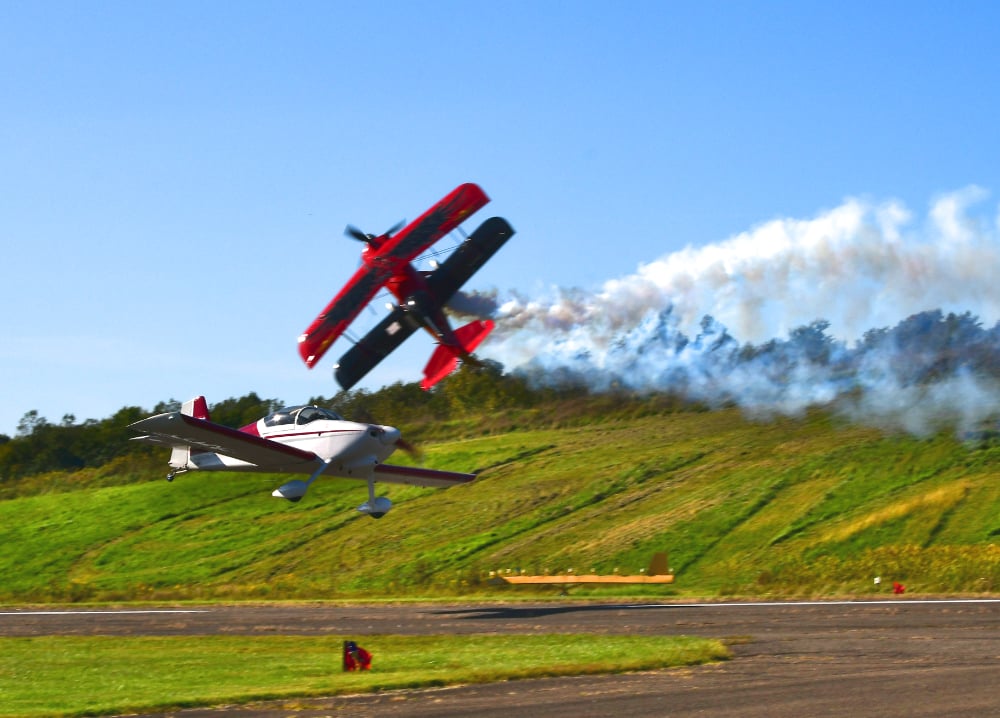
After Tico and Brett’s act, Ted and Scott jumped once again and the show was over. Everybody left quietly and politely, no honking or shouting — people in cities have much to learn from the residents of rural Ohio — and I suppose most of us basked in the pleasure of having seen a fine airshow. (As well as the satisfaction of digesting a regionally famous chicken dinner.)
It felt to me a lot closer to the barnstorming days of a century ago than do any of the bigger shows I’ve attended. The pilots and jumpers best I can tell all live nearby.
What’s best about it is that there is probably a good local airshow near you. You might want to find out and if there is make plans to attend.
There’s probably someone somewhere who wasn’t happy to have been to an airshow, but I don’t know who it would be.
Except, maybe, that Ercoupe pilot.

Dennis E. Powell is crackpot-at-large at Open for Business. Powell was a reporter in New York and elsewhere before moving to Ohio, where he has (mostly) recovered. You can reach him at dep@drippingwithirony.com.
You need to be logged in if you wish to comment on this article. Sign in or sign up here.
Join the Conversation
Re: It's Fun When the Barnstormers Come Round
That last feat makes me nervous just seeing it after the fact — wow, that must be something to witness in person. It sounds like a fantastic show… now just to find one nearby with that kind of chicken to go along with it.